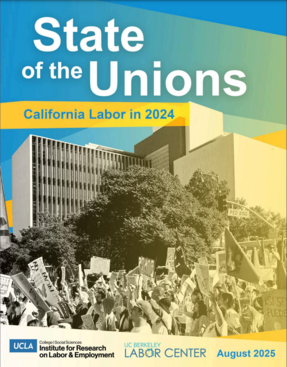State of the Unions: California Labor in 2024
UCLA Institute for Research on Labor and Employment (IRLE):
Justin McBride, Chris Zepeda-Millán, and Cristhian Lin;
UC Berkeley Labor Center:
Savannah Hunter, Enrique Lopezlira, and Patrick Wade;
UC Riverside Inland Empire Labor and Community Center (IELCC):
Jesús “Chuy” Flores, David Mickey-Pabello, and Ellen Reese
This report provides a snapshot of the California labor movement in 2024. Led by researchers at the UCLA Institute for Research on Labor and Employment (IRLE) and the UC Berkeley Labor Center, the publication also features a chapter from the UC Riverside Inland Empire Labor and Community Center (IELCC). The report includes data on union density, member demographics, and labor organizing activity in California and the nation. Additionally, the report features illuminating case studies on worker victories in fast food, warehousing, and agriculture.
Introduction
These are uncertain times for workers and unions in California and the nation. On the one hand, support for unions is historically high, especially among young people. Recent strikes across industries as diverse as K-12 and higher education, auto manufacturing, film and television, and healthcare, to name a few, have galvanized non-union workers and increased awareness of the benefits of belonging to a union. On the other hand, union density at a national level continues to decline while the second Trump administration threatens to hobble federal regulatory agencies, including the National Labor Relations Board, and fire tens of thousands of federal workers. The impact of the administration’s trade and tariff policies on the labor market remains uncertain. Additionally, the administration's mass deportation agenda is likely to have an impact on the state's labor force this year and beyond.
This edition of “State of the Unions” offers a profile of the unions in California on the cusp of potentially momentous political and economic changes. Compiling public data from 2024 about union membership, union elections, and strike activity, the report serves as a benchmark to measure the impact of changes in labor policy, worker power, and the health of organized labor.
Labor leaders, journalists, policymakers, and union members will find a complex story of union activity in the following report. Part I draws on statewide public data on union membership, union elections, and strike and protest activity by unions, identifying geographic, sectoral, and organizational patterns of change. Part II digs deeper into union activity in three important economic sectors: fast food, warehousing, and agriculture.
Key Findings
- Union density in California has held steady for over two decades in defiance of national trends of long-term decline. In 2024, one in six California workers (16.3% or 2.67 million) was represented by a labor union.
- California’s union members represent the state’s diversity. The typical union member in California is in their mid-40s, a person of color born in the United States, and has obtained educational experiences beyond high school. Union members are equally likely to be male or female. However, some groups are underrepresented in labor’s ranks, and others are likely undercounted in public data.
- Given the opportunity to vote in a union election, a large majority of California workers choose union representation. In 2024, unions filed petitions for over 300 elections covering nearly 25,000 workers. Workers voted for union representation in over 83% of those elections, a slightly higher success rate than the nation as a whole.
- State labor policy remains critical for worker protections across many sectors of the economy. From sectoral bargaining to heat and workplace technology regulations, California workers and unions have a major interest in state-level policy.
This year’s report also reflects growing coordination between labor research programs across the University of California system. Anchored by staff at the UCLA Institute for Research on Labor and Employment (IRLE) and the UC Berkeley Labor Center, we’re pleased to highlight a contribution from the Inland Empire Labor and Community Center (IELCC) at UC Riverside. The IELCC is one of six new UC labor centers supporting labor organizations and workers across the diverse regions of California.
Toby Higbie, Director, UCLA Institute for Research on Labor and Employment (IRLE)
Brenda Muñoz, Executive Director, UC Berkeley Labor Center

